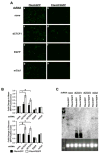Drosophila CTCF is required for Fab-8 enhancer blocking activity in S2 cells
- PMID: 17825318
- PMCID: PMC2694738
- DOI: 10.1016/j.jmb.2007.07.065
Drosophila CTCF is required for Fab-8 enhancer blocking activity in S2 cells
Abstract
CTCF is a conserved transcriptional regulator with binding sites in DNA insulators identified in vertebrates and invertebrates. The Drosophila Abdominal-B locus contains CTCF binding sites in the Fab-8 DNA insulator. Previous reports have shown that Fab-8 has enhancer blocking activity in Drosophila transgenic assays. We now confirm the enhancer blocking capability of the Fab-8 insulator in stably transfected Drosophila S2 cells and show this activity depends on the Fab-8 CTCF binding sites. Furthermore, knockdown of Drosophila CTCF by RNAi in our stable cell lines demonstrates that CTCF itself is critical for Fab-8 enhancer blocking.
Figures



Similar articles
-
CTCF is conserved from Drosophila to humans and confers enhancer blocking of the Fab-8 insulator.EMBO Rep. 2005 Feb;6(2):165-70. doi: 10.1038/sj.embor.7400334. EMBO Rep. 2005. PMID: 15678159 Free PMC article.
-
CTCF genomic binding sites in Drosophila and the organisation of the bithorax complex.PLoS Genet. 2007 Jul;3(7):e112. doi: 10.1371/journal.pgen.0030112. PLoS Genet. 2007. PMID: 17616980 Free PMC article.
-
Fragments of the Fab-3 and Fab-4 Boundaries of the Drosophila melanogaster Bithorax Complex That Include CTCF Sites Are not Effective Insulators.Dokl Biochem Biophys. 2022 Feb;502(1):21-24. doi: 10.1134/S1607672922010069. Epub 2022 Mar 11. Dokl Biochem Biophys. 2022. PMID: 35275301 Free PMC article.
-
We gather together: insulators and genome organization.Curr Opin Genet Dev. 2007 Oct;17(5):400-7. doi: 10.1016/j.gde.2007.08.005. Epub 2007 Oct 24. Curr Opin Genet Dev. 2007. PMID: 17913488 Free PMC article. Review.
-
CTCF function is modulated by neighboring DNA binding factors.Biochem Cell Biol. 2011 Oct;89(5):459-68. doi: 10.1139/o11-033. Epub 2011 Sep 7. Biochem Cell Biol. 2011. PMID: 21895576 Review.
Cited by
-
Orientation-dependent interaction between Drosophila insulators is a property of this class of regulatory elements.Nucleic Acids Res. 2008 Dec;36(22):7019-28. doi: 10.1093/nar/gkn781. Epub 2008 Nov 5. Nucleic Acids Res. 2008. PMID: 18987002 Free PMC article.
-
Chromatin domain boundary element search tool for Drosophila.Nucleic Acids Res. 2012 May;40(10):4385-95. doi: 10.1093/nar/gks045. Epub 2012 Jan 28. Nucleic Acids Res. 2012. PMID: 22287636 Free PMC article.
-
High-resolution mapping defines the cooperative architecture of Polycomb response elements.Genome Res. 2014 May;24(5):809-20. doi: 10.1101/gr.163642.113. Epub 2014 Mar 25. Genome Res. 2014. PMID: 24668908 Free PMC article.
-
Functional Dissection of the Blocking and Bypass Activities of the Fab-8 Boundary in the Drosophila Bithorax Complex.PLoS Genet. 2016 Jul 18;12(7):e1006188. doi: 10.1371/journal.pgen.1006188. eCollection 2016 Jul. PLoS Genet. 2016. PMID: 27428541 Free PMC article.
-
Bi-functional cross-linking reagents efficiently capture protein-DNA complexes in Drosophila embryos.Fly (Austin). 2014;8(1):43-51. doi: 10.4161/fly.26805. Epub 2013 Dec 13. Fly (Austin). 2014. PMID: 24135698 Free PMC article.
References
-
- Georgiev PG, Gerasimova TI. Novel genes influencing the expression of the yellow locus and mdg4 (gypsy) in Drosophila melanogaster. Mol Gen Genet. 1989;220:121–126. - PubMed
-
- Zhao K, Hart CM, Laemmli UK. Visualization of chromosomal domains with boundary element-associated factor BEAF-32. Cell. 1995;81:879–889. - PubMed
-
- Bell AC, West AG, Felsenfeld G. The protein CTCF is required for the enhancer blocking activity of vertebrate insulators. Cell. 1999;98:387–396. - PubMed
Publication types
MeSH terms
Substances
Grants and funding
LinkOut - more resources
Full Text Sources
Molecular Biology Databases

